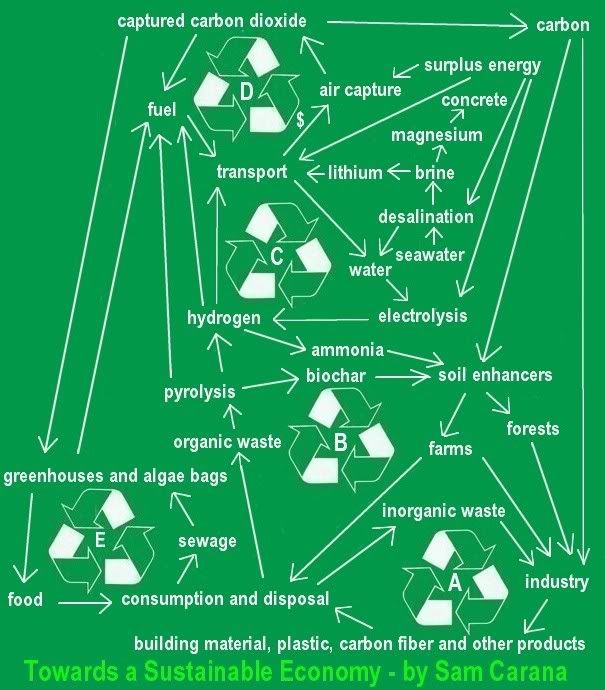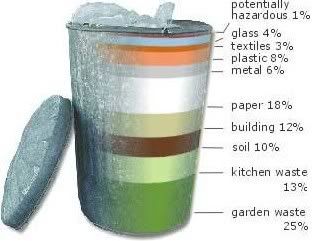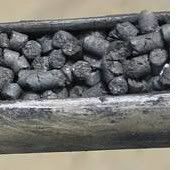Feebates are the most effective way to facilitate the shift towards a sustainable economy
Local feebates are proposed to facilitate a shift away from fossil fuel toward clean energy. Further feebates are proposed (i.e. fees on livestock products, nitrogen fertilizers, Portland cement and similar products with high emissions), to finance rebates on methods that can remove large amounts of greenhouse gases from the atmosphere, such as biochar burial and olivine grinding. In general, feebates are most effective in dealing with pollution. The post below was written in 2011.
Cycle A: Inorganic Waste
We're all familiar with recycling. Reusing waste to manufacture new products can help resolve two problems: the economic problem of scarcity of resources and the environmental problem of waste. Dedicated bins can help separate waste and collect glass and plastic containers, to be reused in new products.
Where needed, surcharges can be levied on items, to ensure they are returned at collections points for recycling. Items such as
bottles and car batteries have also been successfully recycled in this way for years by retailers and garages.
Recycling is possible for much of our inorganic waste. The concept of recycling can also be used in a wider sense, in efforts to take surplus carbon out of the atmosphere and oceans, e.g. by adding olivine to materials for building and road construction. This effort will require more recycling than the traditional recycling of inorganic waste.
Cycles B and E: Biomass and Organic Waste
Dr. James Hansen once calculated that reforestation of degraded land and improved agricultural practices that retain soil carbon together could draw down atmospheric carbon dixode by as much as 50 ppm, adding that this and using carbon-negative biofuels could bring carbon dioxide back to
350 ppm well before the end of the century.
Recycling of organic waste constitutes another cycle in a sustainable economy. Soil can be degraded by deforestation and by a failure to return nutrients, carbon and water to the soil. Manure and sewage have long fertilized the land, but are increasingly released in rivers and in the sea, and combined with fertilizer run-off from farms, this causes low-oxygen areas in oceans.
Many people now compost kitchen and garden waste, thus returning many nutrients to the soil. Composting, however, releases greenhouse gases. Pyrolyzing organic waste from households, farms and forests can avoid such emissions.
Pyrolysis is an oxygen-starved method of heating waste at relatively low temperatures that will result in the release of little or no greenhouse gases. With pyrolysis, organic waste can be turned into hydrogen and
agrichar, or
biochar, which can store carbon into the soil and make the soil more fertile.

There is an abundance of soil to sequester biochar. Estimates range from
363 tonnes of CO2 per hectare to
303.8 tons C per hectare. The U.S. has some
475 million hectares of agricultural land. Australia has almost 762 million hectares of land, mostly desert. Desert soils can contain between
14 and 100 tonnes of carbon per ha, while dry shrublands can contain up to 270 tonnes of carbon per ha. The carbon stored in the vegetation is considerably lower, with typical quantities being around 2–30 tonnes of carbon per ha in total. Eucalypt trees grow rapidly and eucalypt forest can store
over 2800 tonnes of carbon per hectare. The FAO-OECD Agricultural Outlook 2009-2018 says (
on page 11) that over 0.8 billion ha of additional land is available for rain-fed crop production in Africa and Latin America. In total, the world has 3.842 billion hectares of land, which could sequester up to
1166 Gt of biochar carbon.
The need to feed a growing world population also makes it imperative to look at ways to increase soil fertility. Biochar will result in better retention of nutrients and water. Once applied, biochar can remain useful for hundreds of years. Increased vegetation in many ways feeds itself. It results in additional input for pyrolysis and thus additional biochar. There are also studies indicating that an increase of vegetation goes hand in hand with an increase in rain. Healthy soil will contain numerous bacteria that increase rain, both when they are in the soil where they
break down the surface tension of water better than any other substance in nature, and when they
become airborne.
Furthermore, there are
indications that forests generate winds that help pump water around the planet, resulting in increased rainfall for forests. This would explain how the deep interiors of forested continents can get as much rain as the coast.
In the 1990s, U.S. farmers needed to implement a soil conservation plan on erodible cropland to be eligible for commodity price supports, and the no-till farmland increased from 7 million hectares in 1990 to
25 million hectares in 2004. Similar policies could be implemented to add biochar, such as making local rates dependent on carbon content.
Using published projections of the use of renewable fuels in the year 2010, biochar sequestration could amount to 5.5 to 9.5 Pg Carbon per year, says Lehmann et al. in Bio-char sequestration in terrestrial ecosystems (2006). That would take carbon dioxide in the atmosphere down by about 1ppm per year.
Cycle C: Clean & Safe Energy
In case of energy, there's not so much a scarcity problem of fossil fuel, but a scarcity of clean energy; a rapid shift to clean ways to produce energy is needed, while additionally surplus carbon needs to be taken out of the atmosphere and oceans, as part of a huge recycling effort to restore natural balance.
To achieve this, it's imperative to electrify transport and shift to renewable energy. Pyrolysis of organic waste can not only produce biochar (as discussed above), but also bio-oils and bio-fuels for use in long distance flights (shorter flights can more easily use batteries or hydrogen).
Surplus energy (see box on right) can close the energy cycle, resulting not only in clean energy, but also leading to a range of new and clean industries, such as water desalination which could in turn result in the production of lithium for car batteries and magnesium for clean concrete.
Electrolyzers can now be made without a need for platinum and there's also interesting research into using electricity to turn seawater into hydrogen. When vehicles run on hydrogen, their output is clean water, rather than emissions.
Cycle D: Air Capture
A rapid shift to clean energy and transport would help bring down levels of carbon dioxide, not only by avoiding emissions, but also by making available large amounts of clean energy at times of low demand.
As such off-peak energy will be relatively cheap, it can be used for purposes such as capture of carbon dioxide from ambient air. Such technologies can be used to power aviation, to feed carbon dioxide to greenhouses, to produce urea and to supply carbon to industry, e.g. for manufacture of building material, plastic, carbon fiber and other products.
Fees on polluting kilns, furnaces, stoves and ovens can also fund rebates on products that avoid emissions, such as clean kilns, efficient electrical appliances, solar cookers, etc.
|
|
Surplus Energy
As the number of wind turbines grows, there will increasingly be periods of time when turbines produce more energy than the grid needs. Especially at night, when demand on the grid is at its lowest, there can be a lot of wind. Unless this energy can somehow be stored or used otherwise, it will go to waste.
Similarly, surplus energy can be produced by solar power facilities. Especially in the early hours of the morning, just after sunrise, the sun can shine brightly, yet there's little or no need for electricity on the grid. It makes sense to store such surplus energy at solar farms in molten salt facilities.
Such surplus energy can be used to help restore the climate, such as by:
- spraying seawater into the sky, to change albedo above oceans
- reforestation, by pumping desalinated water into deserts
|
|
|
Towards a sustainable economy
Instead of burning fuel and throwing things away, there are more sustainable ways to do things. Not only are they environmentally more sustainable and healthy, they also provide good job opportunities and investment potential. While some of these technologies are controversial, in that they aren't natural and their consequences aren't fully known, the need to act on global warming makes that they should be further explored.
Such technologies include:
- clean and safe electricity generation with solar, wind, tide, wave and geothermal power
- using electricity and hydrogen to power transport
- carbon dioxide captured from ambient air
- spraying seawater into the sky, to change albedo above oceans
- pyrolysis to produce biochar, hydrogen and synthetic fuel
- enhancing soil quality with biochar and olivine,resulting in extra biomass for pyrolysis, thus removing more carbon dioxide while young growth is also lighter in color, reflecting more sunlight back into space
- producing rain by means of cloud seeding, using dry ice and urea, produced by means of pyrolysis and from carbon dioxide captured from ambient air
- water desalination for irrigation, residential and industrial purposes
Because many such technologies complement each other, their combination can make them more commercially viable than when looked at in isolation.
The way back to 280 ppm describes how two types of feebates can help bring down carbon dioxide levels both in the atmosphere and in oceans. Energy feebates (yellow arrows in the top half of above image) will encourage the use of solar cookers and clean electricity in transport, lighting, cooking, heating and industrial processes, which will also reduce a range of emissions other than carbon dioxide, such as methane and soot. Biochar and olivine feebates (bottom half of above image) will also reduce a range of pollutants.
Feebates
Feebates are the most effective way to facilitate the shift to technologies that reduce greenhouse gases. Communities can select feebates to suit local circumstances; in fact, feebates are best implemented locally. Feebates can also be implemented in budget-neutral ways, merely insisting on safe and clean products which maximizes the use of market mechanisms to sort out what works best where. Similarly, feebates aiming to have carbon dioxide removed from the atmsophere and the oceans merely need to insist that, to be eligible for rebates, methods need to be effective and safe.
The following seven feebates (the yellow arrows on above images) are particularly recommended:
1. fees on nitrogen fertilizers and on livestock products, funding local rebates on
biochar
2. fees on fuel, funding local rebates on clean and safe electricity
3. fees on engines, funding local rebates on electric motors
5. fees on ovens, kilns and furnaces with high emissions, funding rebates on building insulation and clean ovens, kilns and furnaces, as well as on solar cookers and on electric appliances for cooking and heating
6. fees on industrial processes with many emissions, funding similar processes that are powered by clean electricity and that incorporate carbon in their products
Feebates can be well combined, e.g. feebate 7. and feebate 1. could produce beneficial soil supplements containing both biochar and olivine, while pyrolysis of organic waste can also produce bio-oils that can in turn be used to make
asphalt and be combined with road construction methds that use olivine. In short, many such feebates are
complementary, i.e. one feebate can help another feebate, making the combination even more successful and thus effective.
As another example, industry may at first be reluctant to switch to, say, electric arc furnaces in metal smelting, arguing that it was more efficient to burn coal directly in blast furnaces than to burn coal in power plants first and then bring the resulting electricity to electric arc furnaces. But as other feebates facilitate the shift from fossil fuel to clean ways of producing electricity, it increasingly makes more sense to shift from the traditional blast furnaces to electric arc furnaces.
In conclusion, feebates are highly
recommended to deal with global warming and to help achieve a sustainable economy.
Geoengineering
The image below, from
Geoengineering the climate, by the Royal Society (2009), pictures a number of geoengineering methods that could be deployed to combat global warming, including both CDR and SRM (solar radiation management) methods.
These methods may differ in timescale, cost-effectiveness and wider impact (see e.g.
this post on biomass), but the urgency to act on global warming is such that we may well need all of them to avoid
runaway global warming and to move towards a sustainable economy.
 There is an abundance of soil to sequester biochar. Estimates range from 363 tonnes of CO2 per hectare to 303.8 tons C per hectare. The U.S. has some 475 million hectares of agricultural land. Australia has almost 762 million hectares of land, mostly desert. Desert soils can contain between 14 and 100 tonnes of carbon per ha, while dry shrublands can contain up to 270 tonnes of carbon per ha. The carbon stored in the vegetation is considerably lower, with typical quantities being around 2–30 tonnes of carbon per ha in total. Eucalypt trees grow rapidly and eucalypt forest can store over 2800 tonnes of carbon per hectare. The FAO-OECD Agricultural Outlook 2009-2018 says (on page 11) that over 0.8 billion ha of additional land is available for rain-fed crop production in Africa and Latin America. In total, the world has 3.842 billion hectares of land, which could sequester up to 1166 Gt of biochar carbon.
There is an abundance of soil to sequester biochar. Estimates range from 363 tonnes of CO2 per hectare to 303.8 tons C per hectare. The U.S. has some 475 million hectares of agricultural land. Australia has almost 762 million hectares of land, mostly desert. Desert soils can contain between 14 and 100 tonnes of carbon per ha, while dry shrublands can contain up to 270 tonnes of carbon per ha. The carbon stored in the vegetation is considerably lower, with typical quantities being around 2–30 tonnes of carbon per ha in total. Eucalypt trees grow rapidly and eucalypt forest can store over 2800 tonnes of carbon per hectare. The FAO-OECD Agricultural Outlook 2009-2018 says (on page 11) that over 0.8 billion ha of additional land is available for rain-fed crop production in Africa and Latin America. In total, the world has 3.842 billion hectares of land, which could sequester up to 1166 Gt of biochar carbon. 





 Refrigerants from air conditioners and refrigerators can harm the environment. The refrigerants in older systems can damage the ozone layer, reason why they were later often substituted by hydrofluorocarbons (HFCs). However, HFCs are harmful greenhouse gases - their global warming impact is many times that of carbon dioxide (see table below). Between 2001-2003, the rise in atmospheric concentrations of HFCs was 13-17% per year, according to the IPCC.
Refrigerants from air conditioners and refrigerators can harm the environment. The refrigerants in older systems can damage the ozone layer, reason why they were later often substituted by hydrofluorocarbons (HFCs). However, HFCs are harmful greenhouse gases - their global warming impact is many times that of carbon dioxide (see table below). Between 2001-2003, the rise in atmospheric concentrations of HFCs was 13-17% per year, according to the IPCC.
 Most households only use one or two different waste bins, one bin for general waste and another bin for recyclables such as glass, cans, paper & packaging.
Most households only use one or two different waste bins, one bin for general waste and another bin for recyclables such as glass, cans, paper & packaging. Biochar appears to be the best way to bury carbon in topsoil, resulting in soil restoration and improved agriculture. Agrichar has the potential to remove substantial amounts of CO2 from the atmosphere, as it both buries carbon in the soil and gets more CO2 out of the atmosphere through better growth of vegetation. Agrichar restores soils and increases fertility. It results in plants taking more CO2 out of the atmosphere, which ends up in the soil and in the vegetation. Agrichar feeds new life in the soil and increases respiration, leading to improvements in soil structure, specifically its capacity to retain water and nutrients. Agrichar makes the soil structure more porous, with lots of surface area for water and nutrients to hold onto, so that both water and nutrients are better retained in the soil.
Biochar appears to be the best way to bury carbon in topsoil, resulting in soil restoration and improved agriculture. Agrichar has the potential to remove substantial amounts of CO2 from the atmosphere, as it both buries carbon in the soil and gets more CO2 out of the atmosphere through better growth of vegetation. Agrichar restores soils and increases fertility. It results in plants taking more CO2 out of the atmosphere, which ends up in the soil and in the vegetation. Agrichar feeds new life in the soil and increases respiration, leading to improvements in soil structure, specifically its capacity to retain water and nutrients. Agrichar makes the soil structure more porous, with lots of surface area for water and nutrients to hold onto, so that both water and nutrients are better retained in the soil.


